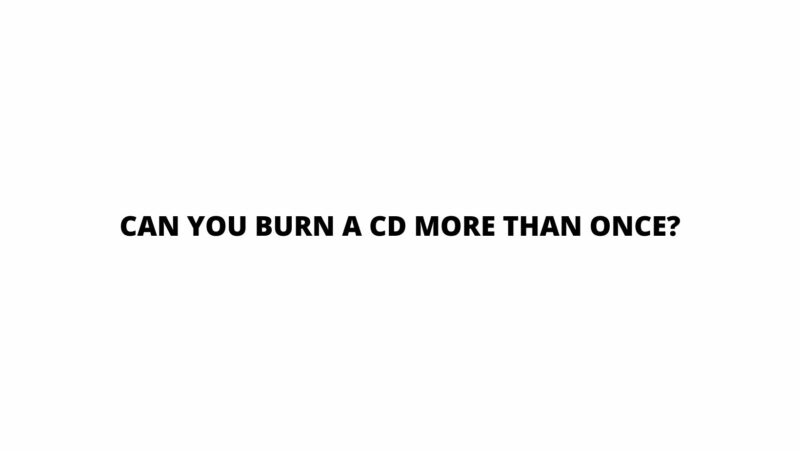In the realm of digital data storage, Compact Discs (CDs) have long been a popular choice for archiving, distributing, and sharing content. A common query that emerges in the context of CD utilization is whether it’s possible to burn a CD more than once. This article delves into the nuances of multi-burning CDs, the technological mechanisms that enable this process, considerations for successful multi-burning, and the implications of repeated burns on data integrity and CD lifespan.
- The Genesis of Multi-Burning
Before delving into the potential of multi-burning, it’s essential to understand the evolution of CD technology. Traditional CD-Rs (Compact Disc-Recordable) were designed as write-once media, allowing data to be permanently recorded on a blank disc. However, advancements in technology led to the development of CD-RW (Compact Disc-Rewritable) discs, which introduced the concept of multi-burning.
- The CD-RW Advantage
CD-RW discs are characterized by their rewritable nature, allowing data to be written, erased, and rewritten multiple times. The technology behind CD-RW discs is distinct from that of CD-Rs, featuring a phase-change material in the dye layer that can undergo reversible changes with the application of heat from a laser.
- Mechanism of Multi-Burning
Multi-burning, specifically associated with CD-RW discs, involves a process known as “packet writing.” This technique allows data to be written and updated incrementally on the disc rather than requiring a full burn at once. Packet writing software manages the process, allowing users to treat the disc like a rewritable storage device, such as a USB drive or hard disk.
- Advantages of Multi-Burning
The ability to burn a CD more than once presents several advantages:
- Dynamic Data Updates: Multi-burning enables users to update or add data incrementally over time, making CD-RW discs suitable for projects that evolve.
- Data Organization: Packet writing allows users to organize data into folders and directories, enhancing the management of content on the disc.
- Efficient Use of Space: With multi-burning, users can utilize the available disc space more efficiently by adding content as needed, minimizing wasted space.
- Considerations for Successful Multi-Burning
While multi-burning offers flexibility, certain considerations are essential to ensure successful outcomes:
- Compatible Drives: Ensure that the CD-RW disc and the CD/DVD drive are compatible with packet writing software to avoid compatibility issues.
- Formatting: Before starting multi-burning, format the CD-RW disc using the packet writing software. This prepares the disc for incremental data updates.
- Closing Sessions: CD-RW discs support multiple sessions, but it’s crucial to close each session before removing the disc to prevent data loss or incompatibility with certain devices.
- Software Reliability: Choose reliable packet writing software that supports your operating system and offers features for data organization and management.
- Implications for Data Integrity
While multi-burning offers flexibility, it’s important to acknowledge potential implications for data integrity:
- Degradation: Each burn cycle subjects the dye layer of a CD-RW disc to stress, potentially impacting data integrity over time. Quality of the dye layer and handling practices play a role in mitigating this.
- Compatibility: Not all devices support packet-written CD-RW discs. Ensure that devices you intend to use for reading the disc are compatible with the format.
- Reliability: Packet writing software can vary in reliability, affecting the success of data updates and the long-term usability of the disc.
- The Evolution of Storage Solutions
As technology continues to evolve, the concept of multi-burning is part of a larger landscape of data storage solutions. Solid-state drives (SSDs), cloud storage, and high-capacity USB drives offer faster access times, larger capacities, and enhanced durability, providing alternatives to physical media.
- Balancing Flexibility and Longevity
The decision to burn a CD more than once hinges on a balance between the flexibility of data updates and the longevity of the CD-RW disc. Factors such as the quality of the disc, handling practices, and the importance of data preservation come into play.
Conclusion
The ability to burn a CD more than once represents a significant advancement in data storage technology. CD-RW discs, enabled by packet writing, offer the flexibility of dynamic data updates and efficient space utilization. However, multi-burning also introduces considerations for data integrity, compatibility, and software reliability.
In the context of evolving storage solutions, the decision to opt for multi-burning should align with the specific requirements of the user, the importance of data preservation, and the availability of alternative options. As technology progresses, the concept of multi-burning remains a testament to the adaptability and enduring relevance of CDs in the digital era.

